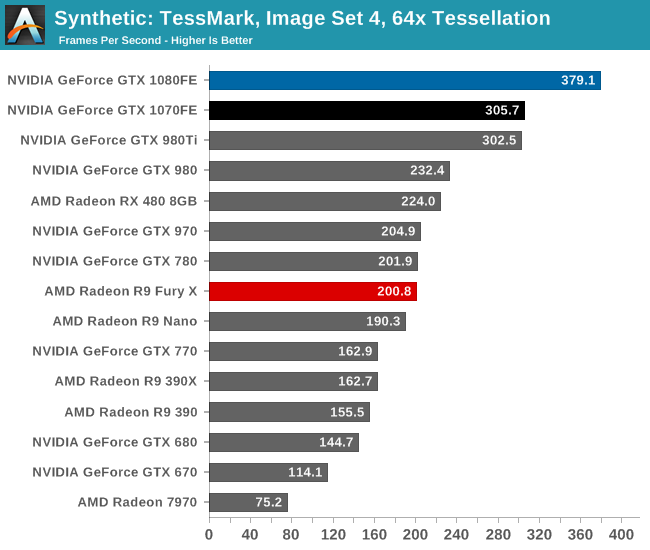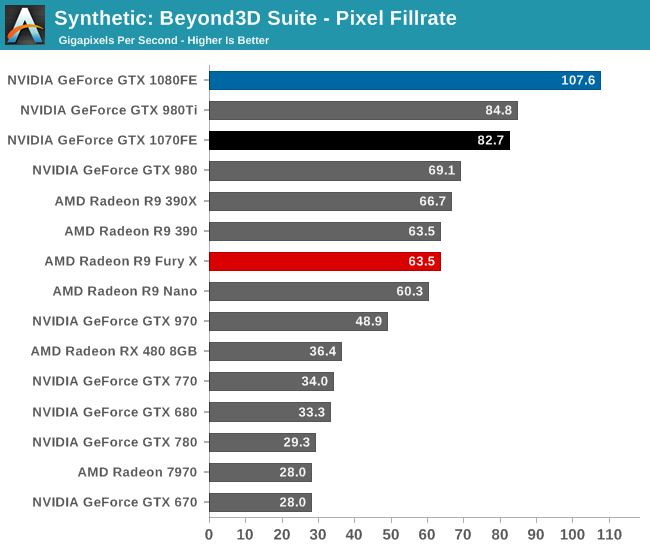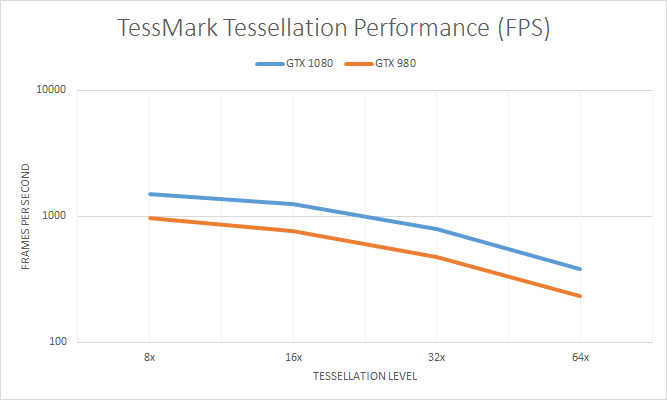The NVIDIA GeForce GTX 1080 & GTX 1070 Founders Editions Review: Kicking Off the FinFET Generation
by Ryan Smith on July 20, 2016 8:45 AM ESTSynthetics
Though we’ve covered bits and pieces of synthetic performance when discussing aspects of the Pascal architecture, before we move on to power testing I want to take a deeper look at synthetic performance. Based on what we know about the Pascal architecture we should have a good idea of what to expect, but these tests none the less serve as a canary for any architectural changes we may have missed.

Starting off with tessellation performance, we find that the GTX 1080 further builds on NVIDIA’s already impressive tessellation performance. Unrivaled at this point, GTX 1080 delivers a 63% increase in tessellation performance here, and maintains a 24% lead over GTX 1070. Suffice it to say, the Pascal cards will have no trouble keeping up with geometry needs in games for a long time to come.
Breaking down performance by tessellation level to look at the GTX 980 and GTX 1080 more closely on a logarithmic scale, what we find is that there’s a rather consistent advantage for the GTX 1080 at all tessellation levels. Even 8x tessellation is still 56% faster. This indicates that NVIDIA hasn’t made any fundamental changes to their geometry hardware (PolyMorph Engines) between Maxwell 2 and Pascal. Everything has simply been scaled up in clockspeed and scaled out in the total number of engines. Though I will note that the performance gains are less than the theoretical maximum, so we're not seeing perfect scaling by any means.
Up next, we have SteamVR’s Performance Test. While this test is based on the latest version of Valve’s Source engine, the test itself is purely synthetic, designed to test the suitability of systems for VR, making it our sole VR-focused test at this time. It should be noted that the results in this test are not linear, and furthermore the score is capped at 11. Of particular note, cards that fail to reach GTX 970/R9 290 levels fall off of a cliff rather quickly. So test results should be interpreted a little differently.

With the minimum recommended GTX 970 and Radeon R9 290 cards get in the mid-to-high 6 range, NVIDIA’s new Pascal cards max out the score at 11. Which for the purposes of this test means that both cards exceed Valve’s recommended specifications, making them capable of running Valve’s VR software at maximum quality with no performance issues.
Finally, for looking at texel and pixel fillrate, for 2016 we have switched from the rather old 3DMark Vantage to the Beyond3D Test Suite. This test offers a slew of additional tests – many of which use behind the scenes or in our earlier architectural analysis – but for now we’ll stick to simple pixel and texel fillrates.

Starting with pixel fillrate, the GTX 1080 is well in the lead. While at 64 ROPs GP104 has fewer ROPs than the GM200 based GTX 980 Ti, it more than makes up for the difference with significantly higher clockspeeds. Similarly, when it comes to feeding those ROPs, GP104’s narrower memory bus is more than offset with the use of 10Gbps GDDR5X. But even then the two should be closer than this on paper, so the GTX 1080 is exceeding expectations.
As we discovered in 2014 with Maxwell 2, NVIDIA’s Delta Color Compression technology has a huge impact on pixel fillrate testing. So most likely what we’re seeing here is Pascal’s 4th generation DCC in action, helping GTX 1080 further compress its buffers and squeeze more performance out of the ROPs.
Though with that in mind, it’s interesting to note that even with an additional generation of DCC, this really only helps NVIDIA keep pace. The actual performance gains here versus GTX 980 are 56%, not too far removed from the gains we see in games and well below the theoretical difference in FLOPs. So despite the increase in pixel throughput due to architectural efficiency, it’s really only enough to help keep up with the other areas of the more powerful Pascal GPU.
As for GTX 1070, things are a bit different. The card has all of the ROPs of GTX 1080 and 80% of the memory bandwidth, however what it doesn’t have is GP104’s 4th GPC. Home of the Raster Engine responsible for rasterization, GTX 1070 can only setup 48 pixels/clock to begin with, despite the fact that the ROPs can accept 64 pixels. As a result it takes a significant hit here, delivering 77% of GTX 1080’s pixel throughput. With all of that said, the fact that in-game performance is closer than this is a reminder to the fact that while pixel throughput is an important part of game performance, it’s often not the bottleneck.

As for INT8 texel fillrates, the results are much more straightforward. GTX 1080’s improvement over GTX 980 in texel throughput almost perfectly matches the theoretical improvement we’d expect based on the specifications (if not slightly exceeding it), delivering an 85% boost. As a result it’s now the top card in our charts for texel throughput, dethroning the still-potent Fury X. Meanwhile GTX 1070 backs off a bit from these gains, as we’d expect, as a consequence of having only three-quarters the number of texture units.











200 Comments
View All Comments
eddman - Wednesday, July 20, 2016 - link
That puts a lid on the comments that Pascal is basically a Maxwell die-shrink. It's obviously based on Maxwell but the addition of dynamic load balancing and preemption clearly elevates it to a higher level.Still, seeing that using async with Pascal doesn't seem to be as effective as GCN, the question is how much of a role will it play in DX12 games in the next 2 years. Obviously async isn't be-all and end-all when it comes to performance but can Pascal keep up as a whole going forward or not.
I suppose we won't know until more DX12 are out that are also optimized properly for Pascal.
javishd - Wednesday, July 20, 2016 - link
Overwatch is extremely popular right now, it deserves to be a staple in gaming benchmarks.jardows2 - Wednesday, July 20, 2016 - link
Except that it really is designed as an e-sport style game, and can run very well with low-end hardware, so isn't really needed for reviewing flagship cards. In other words, if your primary desire is to find a card that will run Overwatch well, you won't be looking at spending $200-$700 for the new video cards coming out.Ryan Smith - Wednesday, July 20, 2016 - link
And this is why I really wish Overwatch was more demanding on GPUs. I'd love to use it and DOTA 2, but 100fps at 4K doesn't tell us much of use about the architecture of these high-end cards.Scali - Wednesday, July 20, 2016 - link
Thanks for the excellent write-up, Ryan!Especially the parts on asynchronous compute and pre-emption were very thorough.
A lot of nonsense was being spread about nVidia's alleged inability to do async compute in DX12, especially after Time Spy was released, and actually showed gains from using multiple queues.
Your article answers all the criticism, and proves the nay-sayers wrong.
Some of them went so far in their claims that they said nVidia could not even do graphics and compute at the same time. Even Maxwell v2 could do that.
I would say you have written the definitive article on this matter.
The_Assimilator - Wednesday, July 20, 2016 - link
Sadly that won't stop the clueless AMD fanboys from continuing to harp on that NVIDIA "doesn't have async compute" or that it "doesn't work". You've gotta feel for them though, NVIDIA's poor performance in a single tech demo... written with assistance from AMD... is really all the red camp has to go on. Because they sure as hell can't compete in terms of performance, or power usage, or cooler design, or adhering to electrical specifications...tipoo - Wednesday, July 20, 2016 - link
Pretty sure critique was of Maxwell. Pascals async was widely advertised. It's them saying "don't worry, Maxwell can do it" to questions about it not having it, and then when Pascal is released, saying "oh yeah, performance would have tanked with it on Maxwell", that bugs people as it shouldScali - Wednesday, July 20, 2016 - link
Nope, a lot of critique on Time Spy was specifically *because* Pascal got gains from the async render path. People said nVidia couldn't do it, so FutureMark must be cheating/bribed.darkchazz - Thursday, July 21, 2016 - link
It won't matter much though because they won't read anything in this article or Futuremark's statement on Async use in Time Spy.And they will keep linking some forum posts that claim nvidia does not support Async Compute.
Nothing will change their minds that it is a rigged benchmark and the developers got bribed by nvidia.
Scali - Friday, July 22, 2016 - link
Yea, not even this official AMD post will: http://radeon.com/radeon-wins-3dmark-dx12/